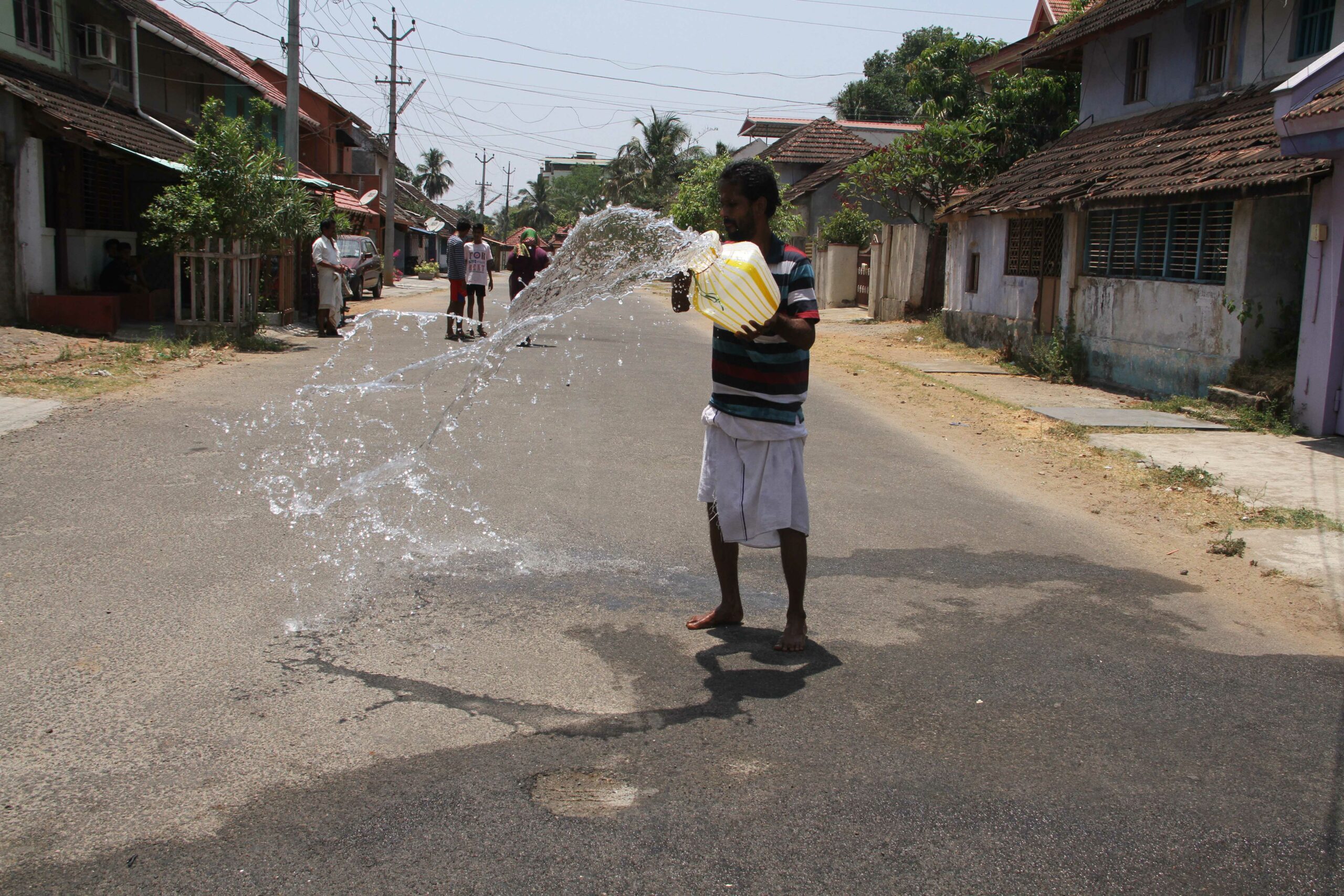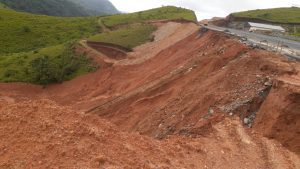The delay in the arrival of the monsoon apart, the changing pattern of the rains is affecting crops and worrying experts.

A resident of Kalpathy in Palakkad attempts managing the dusts by pouring water on the road. (PS Manoj)
Despite the India Meteorological Department’s (IMD) contention that, with the strengthening of the westerly winds over the south Arabian Sea, conditions are turning favourable for the Southwest Monsoon to break over Kerala, rains continue to elude the state.
Normally, the Southwest Monsoon hits the Kerala shores on 1 June, but the rains have been delayed this year. The state is the entry point into India of the monsoons, the lifeline of agriculture across vast swathes of the country.
This year, the IMD had predicted the rains would arrive by 4 June, while the private forecaster Skymet had predicted its arrival date as 7 June.
On Sunday, with no sign of rains, the IMD said it would be another three or four days before the monsoon sets in.
“Conditions are becoming favourable with the increase in westerly winds over the south Arabian Sea. Also, the depth of westerly winds is gradually increasing and today, June 4, the depth of westerlies has reached up to 2.1 kilometres above the mean sea level,” said an IMD statement issued on Sunday.
Meanwhile, intermittent pre-monsoon rains have pushed up humidity levels by as much as 50 percent since the beginning of May, making life in Kerala hellish for most people.
Though there has been a dip of 4 degrees Celsius compared to April, the maximum temperature remains high in the state.
According to S Abhilash, an associate professor with the Department of Atmospheric Sciences at the Cochin University of Science and Technology (Cusat), the monsoon would be delayed by four more days, and the chances of it arriving in all its glory — with near-continuous rain — are not too bright.
He predicted moderate and intermittent rains in June and the first part of July — a replication of the situation in the state since 2018 — with heavy rains after that, from August till well into October.
“IMD reports indicate that the cloud mass over the southeast Arabian Sea is increasing. However, the onset date will not correlate with the monsoon’s performance over the four months. IMD has forecast a normal monsoon this year despite likely El Nino conditions. However, the possibility of adverse incidents like high-intensity cloudbursts of short durations cannot be ruled out,” Abhilash told South First.
“The maximum temperature will go down once the monsoon begins, and the state continuously gets good afternoon rainfall. But such rainfall is unlikely, at least in the coming two weeks,” said Rajeevan Erikkulam, a meteorologist with the Kerala State Disaster Management Authority.
“Scanty and isolated rainfalls would increase humidity, and people will feel uncomfortable. Only by the end of the month can we expect a steady and regular monsoon season,” Erikkulam told South First.
Despite positive information from IMD, including the assurance that the monsoon delay would not impact the climate and agricultural calendars of the state, Kerala is currently passing through a rain-deficit situation.
The rain deficiency since March this year crossed the 30 percent mark this week.
The poor rainfall has affected hydel power generation as water levels are fast dipping in many reservoirs.
According to Kerala State Electricity Board (KSEB), only 11 percent of water remains in the reservoirs.
Almost all the KSEB and Irrigation Department dams have already touched dead-storage levels.
Contrary to the normal situation at this time of the year, as many as 70 percent of the local bodies in Kerala are currently facing extreme water scarcity and depend on water-carrying trucks.
Farmers are a worried lot as the severe water shortage has almost fully crippled their agricultural planning, especially for rice, vegetables, and cash crops.
Since the floods of 2018, large-scale deluges and devastation due to incessant rains have become an annual phenomenon in Kerala.

A portion of an under-constriction airstrip caved in due to the rains in Idukki during monsoon in June 2022. (South First)
However, even many areas worst affected by the floods in the previous years are witnessing a drought-like situation.
In the traditional rice bowls of Kerala — like Palakkad, Kuttanad, and Wayanad — farmers are staring at the sky with anxiety writ large on their faces.
Among the districts, only Thiruvananthapuram and Kozhikode received relatively better rainfall this time.
While experts blame climate change, an unprecedented water crisis engulfs the whole state. It’s extremely severe in the Kasargod district.
Plantation crops like coffee, tea, rubber, cardamom and pepper will witness a lower output this year because of the below-average rainfall witnessed by Kerala in the last two weeks. The cardamom harvest will likely be delayed by more than a month because of the rain deficit.
Coffee farmers in Wayanad and tea estates in Idukki are also badly affected. The lack of showers has started affecting the setting of coffee beans, and insufficient moisture prevents the growers from applying fertilisers.
The scanty rainfall is also adversely affecting the rubber growers of Kerala, the largest producer of the commodity in the entire country.
A decline in yield is anticipated during the peak tapping season starting in September because of the lack of rain.
According to Dr Pratheesh Mamman, a researcher at the Institute for Climate Change Studies in Kottayam, many elements, including global warming, cause climate change, resulting in changes in rain patterns.
“El Nino, associated with the heating of Pacific waters, is having a huge impact on the monsoon in the state. It adversely affects the atmospheric conditions needed for moist monsoon winds,” he said.
According to Dr Gopakumar Cholayil, a faculty member with Kerala Agriculture University who has researched the changing rain patterns of the state, the monsoon rains have been decreasing steadily since 1980.
“Gone are the days when Kerala was adjudged as one of the rainiest pockets of India. The concept about June as the rainiest month for the state, with 650 mm of rain, is also changing,” he said.
According to him, the state had witnessed a 30 percent decrease in annual rainfall since 1980.
“Earlier, Kerala received modest rains in 10 months of the year. Now, not even minor showers are happening in five months. Though the state witnessed heavy rains last August, there were only modest rains reported in September,” he told South First.
According to him, the impact on Kerala residents would be severe, as a single person uses an average of 400 litres of water daily while the global average is 135 litres.
Meanwhile, Dr VP Dinesan, senior scientist with the Kozhikode-based Centre for Water Resources Development and Management (CWRDM), warns of extreme water scarcity in the coming months, even if the monsoon picks up momentum by June end.
“Whatever the availability of rain, the water is not getting stored in the earth. Repeated floods, landslides, and other developments have washed away the sand-bed sediments of rivers and filled them with alluvium sediment. This prevents the rainwater from seeping into the earth. Now the rainwater that falls on Kerala soil reaches the sea in 22 hours,” he pointed out.
According to him, groundwater distribution has also decreased remarkably in the state. In the coastal plain, it stands below one meter. The groundwater level in the midlands comprising rolling hills has decreased to two meters. In the highlands or mountainous terrains, it is now below three meters.
According to green activist and advocate Harish Vasudevan, there are many contributing factors to the situation in which rainwater flows easily into the sea without seeping into the soil.
“The forest cover in the state has decreased from 50 percent to 27 percent over the years. Rice fields, which traditionally stored rainwater, have decreased from eight lakh hectares to 2.5 lakh hectares due to large-scale commercially-motivated reclamation. Soil extraction from the hills is another contributing factor. In addition, saline water is entering our rivers up to 28 km inward now,” he points out.
The CWRDM has advised the state government to desilt and protect 45,000 ponds in the state as an immediate measure. Conservation of these ponds would help recharge wells. The agency has also found that the quantity of water in Kerala’s dams is less than the water in dams in Tamil Nadu.
According to some experts, there is an urgent need to revise the agriculture calendar of Kerala in keeping with the changing pattern of rains. They say the planting season, which hitherto began in June, needs to be delayed to July end.

Jul 26, 2024

Jul 26, 2024

Jul 25, 2024

Jul 25, 2024

Jul 25, 2024

Jul 24, 2024